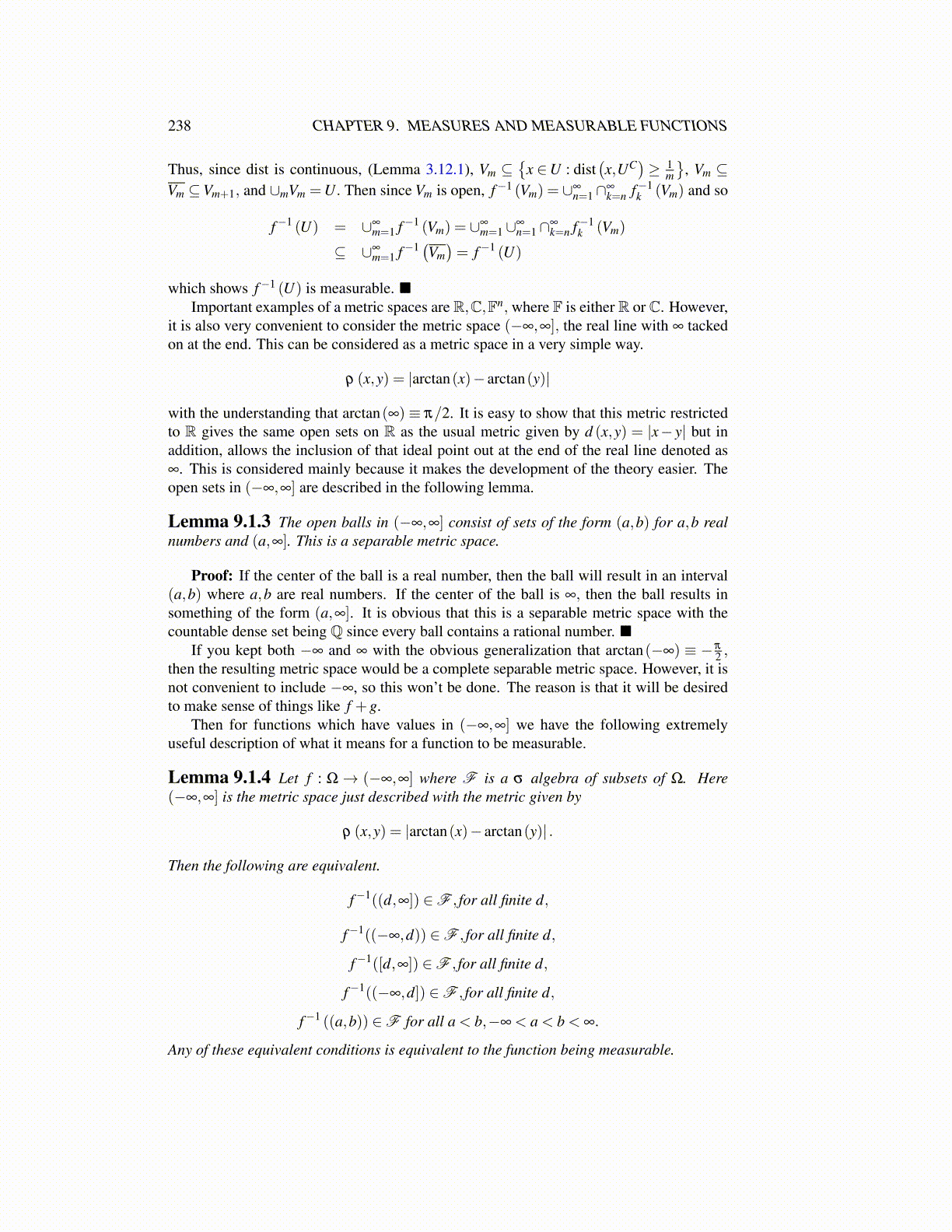
238 CHAPTER 9. MEASURES AND MEASURABLE FUNCTIONS
Thus, since dist is continuous, (Lemma 3.12.1), Vm ⊆{
x ∈U : dist(x,UC
)≥ 1
m
}, Vm ⊆
Vm ⊆Vm+1, and ∪mVm =U. Then since Vm is open, f−1 (Vm) = ∪∞n=1∩∞
k=n f−1k (Vm) and so
f−1 (U) = ∪∞m=1 f−1 (Vm) = ∪∞
m=1∪∞n=1∩∞
k=n f−1k (Vm)
⊆ ∪∞m=1 f−1 (Vm
)= f−1 (U)
which shows f−1 (U) is measurable. ■Important examples of a metric spaces are R,C,Fn, where F is either R or C. However,
it is also very convenient to consider the metric space (−∞,∞], the real line with ∞ tackedon at the end. This can be considered as a metric space in a very simple way.
ρ (x,y) = |arctan(x)− arctan(y)|
with the understanding that arctan(∞) ≡ π/2. It is easy to show that this metric restrictedto R gives the same open sets on R as the usual metric given by d (x,y) = |x− y| but inaddition, allows the inclusion of that ideal point out at the end of the real line denoted as∞. This is considered mainly because it makes the development of the theory easier. Theopen sets in (−∞,∞] are described in the following lemma.
Lemma 9.1.3 The open balls in (−∞,∞] consist of sets of the form (a,b) for a,b realnumbers and (a,∞]. This is a separable metric space.
Proof: If the center of the ball is a real number, then the ball will result in an interval(a,b) where a,b are real numbers. If the center of the ball is ∞, then the ball results insomething of the form (a,∞]. It is obvious that this is a separable metric space with thecountable dense set being Q since every ball contains a rational number. ■
If you kept both −∞ and ∞ with the obvious generalization that arctan(−∞) ≡ −π
2 ,then the resulting metric space would be a complete separable metric space. However, it isnot convenient to include −∞, so this won’t be done. The reason is that it will be desiredto make sense of things like f +g.
Then for functions which have values in (−∞,∞] we have the following extremelyuseful description of what it means for a function to be measurable.
Lemma 9.1.4 Let f : Ω→ (−∞,∞] where F is a σ algebra of subsets of Ω. Here(−∞,∞] is the metric space just described with the metric given by
ρ (x,y) = |arctan(x)− arctan(y)| .
Then the following are equivalent.
f−1((d,∞]) ∈F , for all finite d,
f−1((−∞,d)) ∈F , for all finite d,
f−1([d,∞]) ∈F , for all finite d,
f−1((−∞,d]) ∈F , for all finite d,
f−1 ((a,b)) ∈F for all a < b,−∞ < a < b < ∞.
Any of these equivalent conditions is equivalent to the function being measurable.